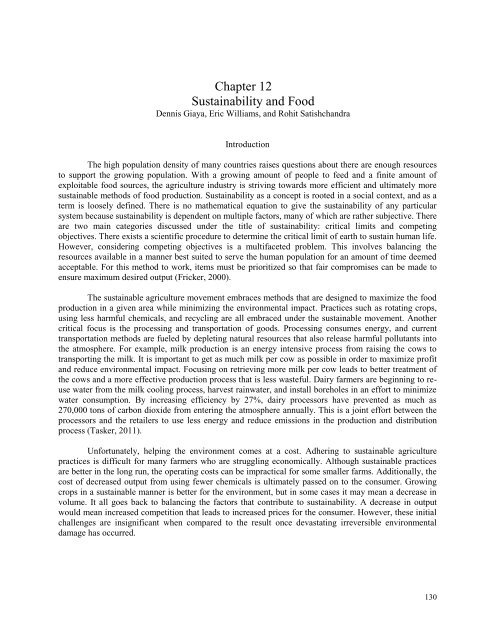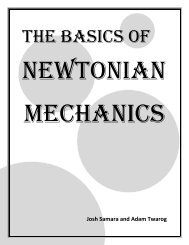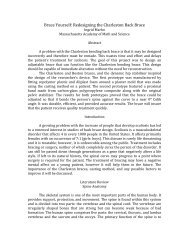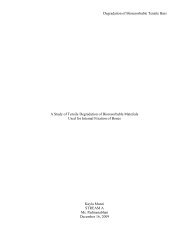Got Food? - the Scientia Review
Got Food? - the Scientia Review
Got Food? - the Scientia Review
You also want an ePaper? Increase the reach of your titles
YUMPU automatically turns print PDFs into web optimized ePapers that Google loves.
Chapter 12<br />
Sustainability and <strong>Food</strong><br />
Dennis Giaya, Eric Williams, and Rohit Satishchandra<br />
Introduction<br />
The high population density of many countries raises questions about <strong>the</strong>re are enough resources<br />
to support <strong>the</strong> growing population. With a growing amount of people to feed and a finite amount of<br />
exploitable food sources, <strong>the</strong> agriculture industry is striving towards more efficient and ultimately more<br />
sustainable methods of food production. Sustainability as a concept is rooted in a social context, and as a<br />
term is loosely defined. There is no ma<strong>the</strong>matical equation to give <strong>the</strong> sustainability of any particular<br />
system because sustainability is dependent on multiple factors, many of which are ra<strong>the</strong>r subjective. There<br />
are two main categories discussed under <strong>the</strong> title of sustainability: critical limits and competing<br />
objectives. There exists a scientific procedure to determine <strong>the</strong> critical limit of earth to sustain human life.<br />
However, considering competing objectives is a multifaceted problem. This involves balancing <strong>the</strong><br />
resources available in a manner best suited to serve <strong>the</strong> human population for an amount of time deemed<br />
acceptable. For this method to work, items must be prioritized so that fair compromises can be made to<br />
ensure maximum desired output (Fricker, 2000).<br />
The sustainable agriculture movement embraces methods that are designed to maximize <strong>the</strong> food<br />
production in a given area while minimizing <strong>the</strong> environmental impact. Practices such as rotating crops,<br />
using less harmful chemicals, and recycling are all embraced under <strong>the</strong> sustainable movement. Ano<strong>the</strong>r<br />
critical focus is <strong>the</strong> processing and transportation of goods. Processing consumes energy, and current<br />
transportation methods are fueled by depleting natural resources that also release harmful pollutants into<br />
<strong>the</strong> atmosphere. For example, milk production is an energy intensive process from raising <strong>the</strong> cows to<br />
transporting <strong>the</strong> milk. It is important to get as much milk per cow as possible in order to maximize profit<br />
and reduce environmental impact. Focusing on retrieving more milk per cow leads to better treatment of<br />
<strong>the</strong> cows and a more effective production process that is less wasteful. Dairy farmers are beginning to reuse<br />
water from <strong>the</strong> milk cooling process, harvest rainwater, and install boreholes in an effort to minimize<br />
water consumption. By increasing efficiency by 27%, dairy processors have prevented as much as<br />
270,000 tons of carbon dioxide from entering <strong>the</strong> atmosphere annually. This is a joint effort between <strong>the</strong><br />
processors and <strong>the</strong> retailers to use less energy and reduce emissions in <strong>the</strong> production and distribution<br />
process (Tasker, 2011).<br />
Unfortunately, helping <strong>the</strong> environment comes at a cost. Adhering to sustainable agriculture<br />
practices is difficult for many farmers who are struggling economically. Although sustainable practices<br />
are better in <strong>the</strong> long run, <strong>the</strong> operating costs can be impractical for some smaller farms. Additionally, <strong>the</strong><br />
cost of decreased output from using fewer chemicals is ultimately passed on to <strong>the</strong> consumer. Growing<br />
crops in a sustainable manner is better for <strong>the</strong> environment, but in some cases it may mean a decrease in<br />
volume. It all goes back to balancing <strong>the</strong> factors that contribute to sustainability. A decrease in output<br />
would mean increased competition that leads to increased prices for <strong>the</strong> consumer. However, <strong>the</strong>se initial<br />
challenges are insignificant when compared to <strong>the</strong> result once devastating irreversible environmental<br />
damage has occurred.<br />
130
















